What we liked about the Powerstation solar panel kit:
Long lasting LiFePo battery
Small dimensions
Lots of contacts
Strong enough for traditional camping gear.
Media presentation
Powerful and small foldable solar panel
least:
Loud fan when using 220V
Solar panel input blocks 100W USB-C port
Solar panels hardly provide any electricity when they are (partially) shaded.
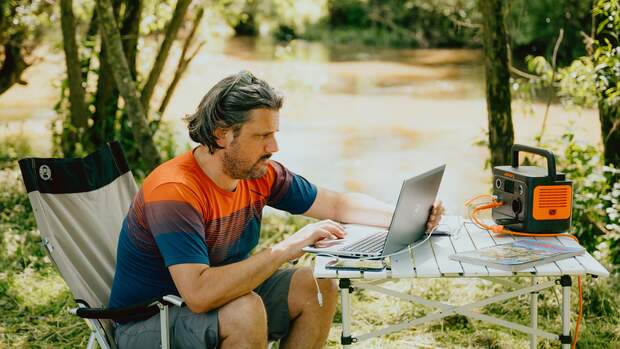
Jana Schuler
The Explorer 300 Plus' performance is easily enough for a day of computing.
Power plant and solar panels in trial use
Camping power station manufacturers are also taking advantage of the current sharp drop in storage prices around the world. One of the cheapest deals currently comes from Jackery, which offers the Powerstation Explorer 300 Plus with a 40-watt (IP68) waterproof solar panel for €449. We took the kit with us into the countryside for several weeks: in the camper (where the kit mainly powers the cooler box), in the meadow of the tent (where the hand blender, lights and coffee grinder are powered) and on a cargo bike ride to the mobile office, where I keep my laptop and smartphone powered.
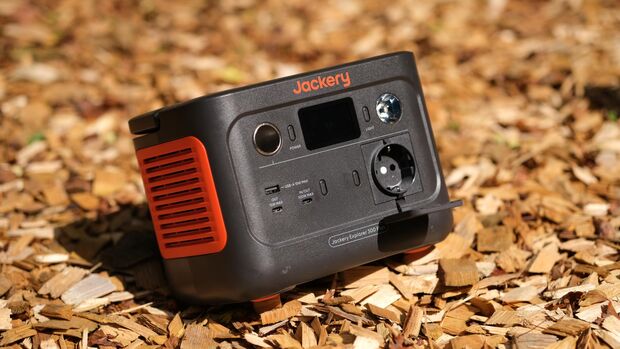
Boris Genilka
There is a USB-A port and two USB-C ports, plus a 220V socket and a 12V car connection with a maximum of 120W.
Contacts for each application
Despite its compact dimensions, the Jackery Explorer 300 Plus has plenty of ports: a 15W USB-A output, and two USB-C ports, one with a 15W output and the other acting as both an input and an output. Or sucking down a generous 100W. The solar panel is also connected via this port. While the power station is charged via the solar panel, there are only two weak USB ports available to power devices. However, there is still a car connection (cigarette lighter plug), which provides 120W, and a 220V AC connection with a nominal output of 300W. At its peak, it should reach 600W. If you want to charge the power station from a socket at home, there is another connection available and the cable for that is also included.
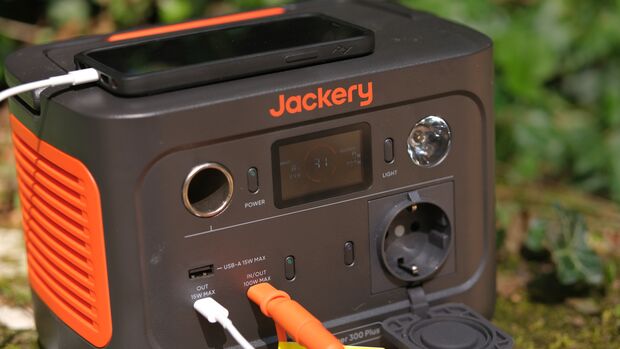
Boris Genilka
This can also be done at the same time: charge the power station (orange cable) and charge your cell phone.
Charging via socket and solar energy
The fastest way to charge the power station is to use an electrical outlet at home – it only takes about two hours. But this is rarely available at the campsite; here you have to rely on sunlight. In testing, the solar panel delivered a maximum of 32 watts at noon under a clear, bright July sky. However, you have to align it perfectly with the sun and make sure that no leaf or branch casts shadows on the solar panel. Then the performance drops dramatically, usually to 1-2 watts. Even with light cloud cover, the performance drops to between 5 and 10 watts. Electricity is provided in this area even when the sun is low, i.e. in the morning and evening. To fully charge the Explorer 300 Plus from a full charge, you need an average of two sunny days with a 40-watt panel. Be careful, because you should always reposition the panel so that it faces the sun directly.
Great as an energy source!
The Powerstation Explorer 300 Plus has proven itself in the test, especially for charging small devices: Smartphones, tablets and laptops can be easily powered via USB. It can also quench the thirst of an Apple MacBookPro, as the USB-C port provides an impressive 100 watts of power. If you want to power a cooler at the same time via the car's 12-volt connection, the power station can do that too – but only for a few hours, by which time its capacity is exhausted. It's good that when using the power bank as a power source, you can also charge via solar power at the same time. At least if you don't need the 100-watt USB-C port, because it is blocked by the solar panel. But there is still a 220-volt connection. In the test, it provided enough power to power a laptop or even a 300-watt hand blender, but it causes the fans in the power station to turn on. It is clearly audible at 40 dB (1 meter). It is best not to use the 220-volt connection in a tent or camper at night. But this shouldn't be necessary, as cooler boxes can always be powered via a 12V car connection.
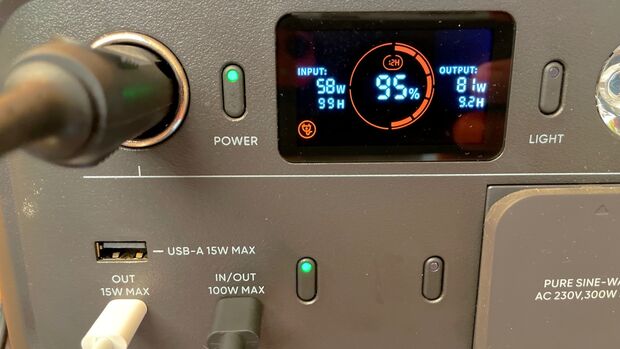
Boris Genilka
All information at a glance. The display turns off after a few seconds and can be activated again by pressing a button.
Media presentation
We really like the display. It provides information about the percentage charge status, the current power input (charging current) and the output power. It also shows the expected time until it is fully charged or fully discharged. Of course, you can also see everything on your smartphone – if you have installed the app in advance and paired it with the device.
Overall, the Jackery Explorer 300 Plus offers very good performance. Especially if you are looking for a lightweight and compact power station for a weekend, for example – and only need 220V in exceptional cases, i.e. for a short time, the kit is well worth the money. At 3,850 grams, the Explorer 300 Plus is easy to throw into a backpack and take with you on a hike. The board can also be folded up small, but it weighs a lot at 1,450 grams. If you make sure it is free of shadows, it can keep the power station running for several days. At least if there are not too many thirsty consumers attached to it.
Technical data:
Jackery Explorer 300 Plus Power Station
- Capacity: Lithium Ion 22.5Ah 12.8VDC (288Wh)
- Cell Chemistry: LFP (LiFePO4 Battery)
- Life cycles: 3000 cycles at 80% capacity
- AC Output: 230V, 300W, 600W Max
- AC input: 220-240V, 10A max
- USB-A Output (×1): 15W
- USB-C Output (×2): 100W
- Total USB Output: USB-C (in/out): 100W max, USB-C (out) + USB-A: 24W max
- Auto Output (x1): 12V – 10A
- DC Input: 12V-27V-5A Max, 100W Max
- Charging time (0-100%) for AC adapter: about 2 hours.
- Charging time (0-100%) USB-C charging: about 4 hours.
- Charging time (0-100%) Car adapter (12V): about 5.5 hours.
- Operating temperature: -10°C~45°C
- Dimensions: 16.7 x 23 x 15.6 cm
- Weight: 3.8 kg
Jackery SolarSaga 40 Small Solar Panel
- Peak power: 40W ± 5%
- Power voltage: 25V±5%
- Water resistance: IP68
- Weight: 1.45 kg with cable
- Dimensions (unfolded): 10 x 30 x 1.9 cm
- Dimensions (folded): 25 x 30 x 3 cm

“Social media evangelist. Baconaholic. Devoted reader. Twitter scholar. Avid coffee trailblazer.”






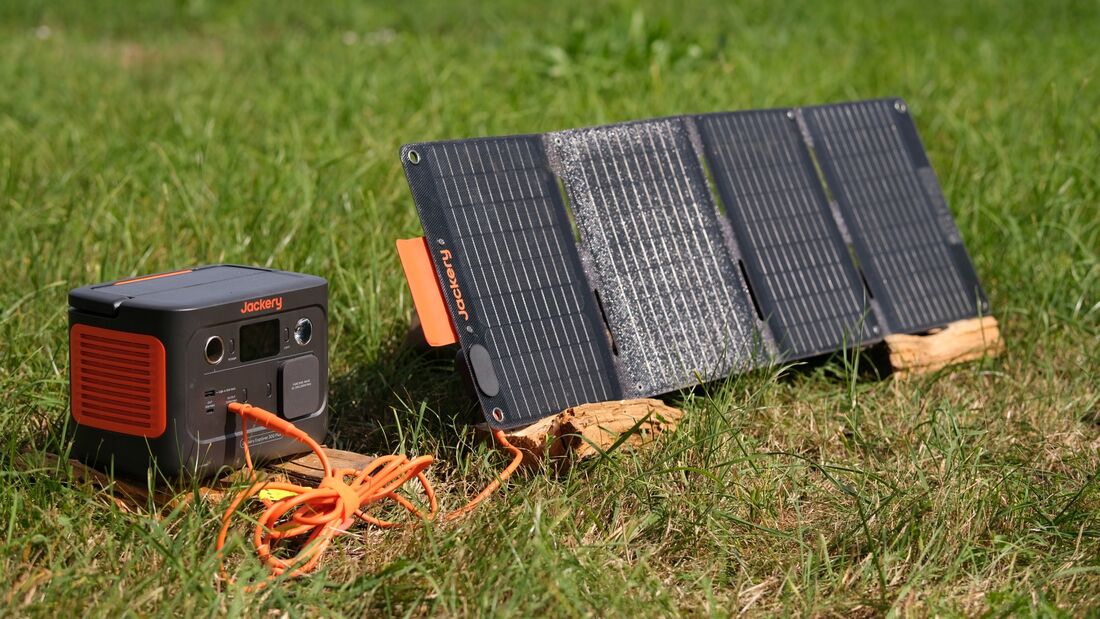

More Stories
Longest jets in the universe discovered – giant particle streams as long as 140 Milky Way galaxies in a row
New method reveals 307 supernova remnants
Snapchat is upping the ante on augmented reality glasses